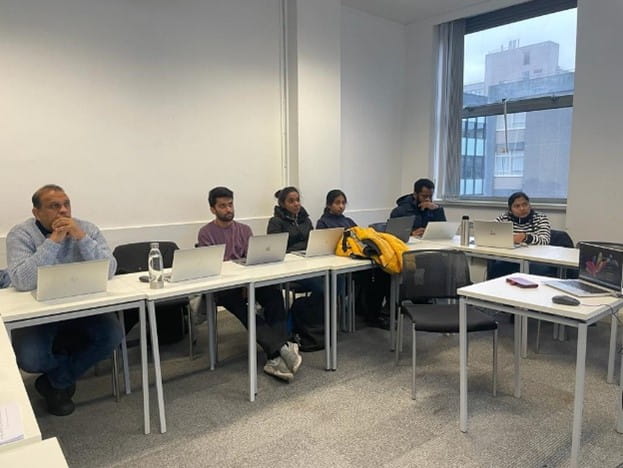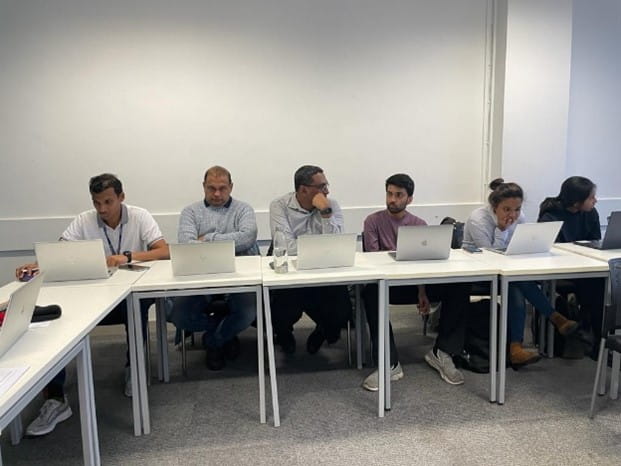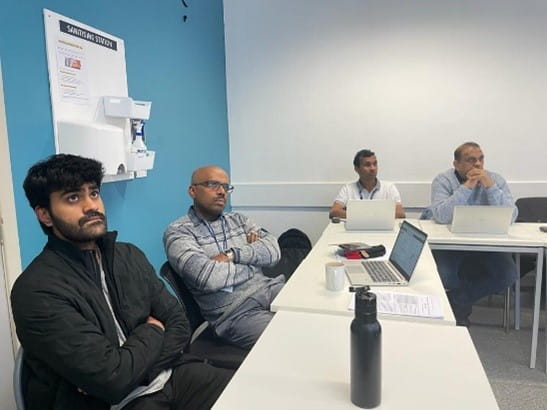Workshop Title:
A Machine Learning based Image Analytic for Rating Image Advertisements
Date:
January 2nd, 2024 (GMT)
Organizer:
Department of Computer and Information Sciences, University of Strathclyde, UK
Keywords:
- Machine Learning
- Image Analytics
- Explainable AI
- Digital Advertising
Workshop Chair:
Personal Bio:
Prof. Anil Fernando received the B.Sc. (Hons.) degree (First Class) in electronics and telecommunication engineering from the University of Moratuwa, Sri Lanka, in 1995, and the M.Sc. in Communications (Distinction) from the Asian Institute of Technology, Bangkok, Thailand in 1997 and Ph.D. in Computer Science (Video Coding and Communications) from the University of Bristol, UK in 2001. He is a professor in Video Coding and Communications at the Department of Computer and Information Sciences, University of Strathclyde, UK. He leads the video coding and communication research team at Strathclyde. He has worked on major national and international multidisciplinary research projects and led most of them. He has published over 425 papers in international journals and conference proceedings and published a book on 3D video broadcasting. He has been working with all major EU broadcasters, BBC, and major European media companies/SMEs in the last decade in providing innovative media technologies for British and EU citizens. His main research interests are in Video coding and Communications, Machine Learning (ML) and Artificial Intelligence (AI), Semantic Communications, Signal Processing, Networking and Communications, Interactive Systems, Resource Optimizations in 6G, Distributed Technologies, Media Broadcasting and Quality of Experience (QoE).
Workshop Description:
Background:
The creative industries in Europe make a significant contribution to the EU economy, generating about 3% of the EU GDP - corresponding to an annual market value of £570 billion - and employing about 7.6 million people. Advertising is one of the main industries within the creative industry and provides millions of jobs across the globe. The industry was shaken when the European advertising market was estimated to potentially lose £60 billion in 2020 due to the recent pandemic. Furthermore, a recent report from Deloitte showed that the advertising industry has a strong impact on the UK's creative industry, providing, for example, two thirds of media revenues add at least GBP 100 billion to the UK GDP. It is also found that over 650,000 people work in jobs that are funded by advertising revenues. According to the report, the impact of advertising is much broader and plays a critical role in making the economy of the UK functional. Despite the significant contribution of creative industries across Europe, the sector which is especially in the area of media and advertising, faces stiff competition particularly from large US-focused companies and the rapid technological development in this field. For instance, the explosion of the Internet for online adverts has forced advertisers to design creative adverts in an effort to maintain the income and high-quality content and to compete with the state-of-the-art advertising technologies.
Many companies around the globe produce and spend lots of money on creating advertisements to promote their products and services to customers. These advertisements serve the purpose of both maximising the selling of their products or services thereby increasing the profit and the desirability of their products. State-of-the-art advertising provided a new dimension to the holistic marketing concepts and new business models by considering the complete value chain. Specially, one of the core pillars of current advertising is the performance marketing which will have a significant enhancement since driving the sales and revenue growth of an organization holistically by reducing advertising costs (which will have a direct impact of reducing the cost of items) and increasing sales. Though the impact of the adverts to increase the sales of the products or services, most of the adverts do not succeed as the current adverts production do not mostly consider the customer Quality of Experience (QoE). A failed advertisement will be a heavy loss to a company in terms of money and time.
In response to these developments, this proposes to harness the powers of Machine Learning (ML) to enable a major boost to the advertising industry by providing high impact adverts to promote products and services from different sectors. The goal of this project is to create a link between a product or a service and a set of ideals. Though state-of-the-art advertising consider different advertising modes such as image, audio, video etc., within this paper, only imaged based adverts was considered due to its popularity specially in printed media and social media.
When an image advertisement is created for a product or service, it should be aesthetically attractive to the customer to get their attention on the product or the service. A highly-experienced advertiser will most likely be able to say whether an advertisement will be successful for a particular target group. However, gaining such experience takes a huge amount of time as an extensive level of learning and research must be done. In most instances, finding an experienced advertiser will be a very costly process. Furthermore, finding an experienced advertiser from unknown territory might also be a challenging task. Since most of us are becoming own advertisers for their day-to-day businesses due to the opportunities provided by social media etc., designing a powerful image-based advert has a significant impact to the society as well. Therefore, it is required to ascertain a different method of classifying an advertisement (e.g., whether it is attractive to a customer or not, giving a rating to the advertisement) and/or to find its impact before publishing it on an advertising channel such as social media, TV, newspaper or another form of electronic media. Furthermore, if the advertiser can predict the failed parts of an advertisement, designers can improve the advertisement and redesign it without creating an entirely new advertisement which will save the time and money for the advertisement companies for launching a successful advert.
Goal/Rationale:
The aim of this research is to design and develop a ML based image analytics to automatically rate image advertisements and extracting the reasons for its predictions for creating a rich targeted advertising ecosystem for advert designers. It is expected that the proposed technologies will provide a major boost to the advertising sector by providing a virtuous circle of competition, innovation and market expansion, to the benefit of consumers and new businesses. The proposed workshop addresses the following objectives.
- Design a Convolutional Neural Network (CNN) based Machine Learning Model for image analytic predictions: A multilayer CNN Model was proposed in rating the image-based advertisements.
- Analyse the results of image analytic predictions from the CNN: A detailed analysis of results from CNN were carried out.
- Use Explainable AI to understand the significance of features and spatial distributions of information and recommend steps in improving the adverts: Explainable AI modules were developed to provide feedback to the advert designers to improve the advert to achieve its expected performance. Local Interpretable Model-agnostic Explanation (LIME) and Integrated Gradients (IG) were used in examining the inputs of the proposed ML framework on their importance to the output and extract the reasons for the rating.
Scope and Information for Participants:
The objective of this workshop is to produce an overview of the historical development and current status of digital advertising while providing an understanding on the challenges and possible future direction in the field. We expect to present our new findings on ML based image advertising and their automatic ratings. Explainable AI techniques will be used in quantifying the ML decisions and to provide feedback for the designers. It is expected to discuss image analytics, ML techniques and explainable AI techniques in detail and their applications on image-based digital advertising ratings and how they can be used for emerging digital advertising. Furthermore, it will be discussed how this can be extended for audio and video-based digital advertising.
Highlight:
This proposes the implementation of an autonomous image advertising rating system, aimed at assisting small and medium-sized enterprises (SMEs) in their efforts to compete in the costly and cutthroat online advertising industry. This algorithm employs a rating methodology to assess and elucidate the placements of these advertisements, so enhancing advertising strategy. This study utilises state-of-the-art Convolutional Neural Networks (CNN) to implement Machine Learning and AI technologies. Advertisement grading and design employ these overlooked technology to assess images. An advertisement database with a strong focus on user involvement was meticulously developed and categorised. The assessment of these advertisements yielded vital data for training the CNN model.
The use of Integrated Gradient methods and LIME (Local Interpretable Model-agnostic Explanations) modules from Explainable AI (XAI) adds relevance to the work. Ad designers derive advantages from the utilisation of these modules' CNN model for decision-making extraction and explanation. Advertisements are enhanced prior to publication using this feature. After rigorous testing, the CNN model accurately predicted more than 90% of the dataset. The study conducts a comparison between LIME and Integrated Gradient explanations in relation to the predictions made by a CNN model. These tactics reveal crucial advertising components that impact model outcomes. Assessing the proposed XAI modules heavily relied on user reviews. The explanations provided by Integrated Gradient were widely agreed upon by users, however the consensus on LIME explanations was lower. The findings demonstrate the CNN model's ability to accurately forecast ad quality, while XAI provides a comprehensive explanation of the decision-making process behind AI-powered advertising.




Venue:
LT403, Department of Computer and Information Sciences, University of Strathclyde, UK

VISA:
Welcome to GOV.UK
In order to ensure the information is correct and up to date, there may be changes which we are not aware of. And different countries have different rules for the visa application. It is always a good idea to check the latest regulations in your country. This page just gives some general information of the visa application.
UK Visa Information
What you need to do
- Check if what you plan to do in the UK is allowed as a Standard Visitor.
- Check you meet the eligibility requirements.
- Check if you need to apply for a visa to visit the UK.
- Apply for a Standard Visitor visa online - if you need one.
Check you meet the eligibility requirements
You must have a passport or travel document to enter the UK. It should be valid for the whole of your stay.
You must be able to show that:
- you'll leave the UK at the end of your visit
- you're able to support yourself and your dependants during your trip (or have funding from someone else to support you)
- you're able to pay for your return or onward journey (or have funding from someone else to pay for the journey)
- you'll not live in the UK for extended periods through frequent or successive visits, or make the UK your main home
Check if you need a visa to visit the UK
Depending on your nationality, you'll either:
- have to apply for a Standard Visitor visa before you travel to the UK
- be able to visit the UK for up to 6 months without needing a visa
You can check if you need a visa before you apply.
If you do not need a visa, you must still meet the Standard Visitor eligibility requirements to visit the UK. You may be asked questions at the UK border about your eligibility and the activities you plan to do.
Attend in person:
If you want to attend the workshop on-site, please email the Conference Committee: info@confciap.org.
